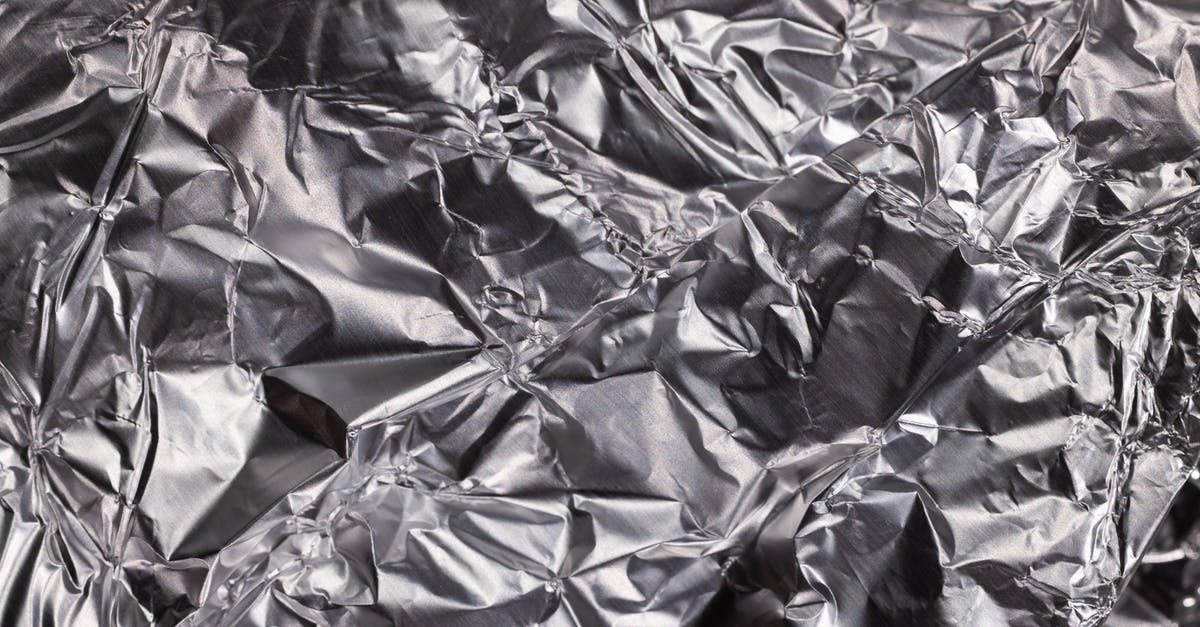Is aluminum foil porous?

When cooking certain items in the oven, I line the baking pan or sheet with aluminum foil. Without fail, when cleaning up, I find oil or juices from the food between the foil and the pan.
I always use one piece of foil, meaning that I have not joined two pieces together, thus there is no seam. I use a large enough piece to extend past the edges of the pan. I use heavy duty foil with no apparent holes or other visible imperfections.
When researching, I have learned that there are porous aluminum foils produced specifically for other applications, and this is by design. But from everything I've read, foil sold for food use is not supposed to be porous.
So, how does this happen?
Best Answer
There are two questions here:
- Is aluminum foil porous (particularly the types of foil sold for household cooking)?
- Is foil's porosity responsible for the liquid that sometimes appears on the other side in cooking/baking applications?
I'd say the brief answers to these questions are (1) sometimes a bit, especially when not using "heavy duty" foil, and (2) perhaps responsible for a small part of the effect in some situations, though how much likely depends on the foil type/quality and how it is used. More details below.
First, aluminum foil can be porous when it is sufficiently thin. This is usually due to small holes left in the manufacturing process. According to Gordon Robinson's Food Packaging: Principles and Practice (3rd ed.):
Aluminum foil is essentially impermeable to gases and water vapor when it is thicker than 15 µm, but it is permeable at lower thicknesses due to the presence of minute pinholes. For example 12 µm thick foil has a WVTR [water vapor transmission rate] of ?0.01 g m-2 day -1, and 8-9 µm thick generally of 0.07-0.1 g m-2 day -1 (Lamberti and Escher, 2007). These values are still far below those of most plastic films used for food packaging....
Other sources give slightly different numbers. The Wiley Encyclopedia of Packaging Technology lists:
0.001 in. (25.4 µm) and thicker is impermeable; 0.00035 in. (8.9 µm) has a WVTR of 0.02g/100in.2 (0.065m2); 24 h at 100°F (37.8°C)
How thick is common household aluminum foil? According to this link:
- "Standard Duty" usually is between 0.0004" and 0.0007" thick.
- Most foil labeled "Heavy Duty" is between .0008" and .001" thick.
- Most foil labeled "Extra Heavy Duty" is between .0011" thick and .0016" thick.
The first source above lists the minimum thickness for impermeability to be about 0.0006" (15 µm, though this may only be for gases, not liquids), while the second source says 0.001". Other sources seem to indicate liquid impermeability requires a minimum thickness of around 0.001". Regardless, it seems likely the "standard duty" foil has some permeability in most cases. On the other hand, "heavy duty" foil is likely completely impermeable (or very nearly so).
But how much is this permeability? At room temperature, it would only allow something like a hundredth of a gram through per day in a pan, probably less. At baking temperatures, permeability would increase, but you still would likely only see a fraction of a gram of liquid getting through during a typical baking period. And for heavy duty foil, the amount should be zero or negligible... at least theoretically.
To move on to the second question, so where does this liquid come from? I myself have seen such liquid even with a double layer of foil or with heavy duty foil.
Other answers have suggested one likely culprit, which is condensation. Ovens often tend to be humid places when uncovered foods are cooking, and food that is in contact with the bottom surface of a pan (and the foil) is generally still cooler than the oven (often the coolest part of the food is on the bottom), which means that humidity will condense on the surface of the pan/foil. It's usually a lot faster for molecules (even larger ones, which often "piggyback" on evaporating water) to move this way in a hot oven than through microscopic pores in the foil.
The other likely issue is imperfections created during the handling of the foil. A perfectly smooth layer of foil removed carefully from the roll may theoretically be impermeable, but bending, crumpling, and otherwise shaping the foil may expand or fracture some tiny pinholes (or other thin sections). All it takes is a few tiny holes (which may not even be visible) to significantly increase the permeability.
Actual leaking may be due to poor manufacture in modern foils or to the severe crumpling done in experiments like this one. (EDIT: See discussion in this thread, which responded to that link with several other experiments. The conclusion was that is was likely design that caused the leak, and some brands of heavy duty foil do seem impermeable to water.)
In any case, it's clear that aluminum foil -- when used practically in home culinary applications -- can sometimes allow some liquid to flow through at a greater rate than the theoretical porosity would suggest.
Pictures about "Is aluminum foil porous?"



Quick Answer about "Is aluminum foil porous?"
In any practical sense in cooking, no, aluminum foil is not porous and will not allow liquids to pass. But it's also (obviously) very fragile, and it's very easy to make small holes, etc., while you're trying to get it to conform to the pan.What happens to aluminum foil when it gets wet?
A: That discoloration is aluminum oxide, a harmless substance that is naturally present on the surface of the foil. When the foil comes in contact with moisture, it can accelerate the buildup of aluminum oxide.Does aluminum foil hold water?
The permeability of pure oxygen through aluminium paper foils was studied. Aluminium paper foil was not permeable for the oxygen.Is aluminum foil gas permeable?
Answer 1: Some plastics wraps are permeable to gases (meaning they allow gases like air to pass through) while some others are not. Aluminum foil however, being a metal foil, has almost no permeability, meaning that no gas (air) can pass through.Why Scientists Warn That Using Aluminium Foil Can Be Dangerous
More answers regarding is aluminum foil porous?
Answer 2
In any practical sense in cooking, no, aluminum foil is not porous and will not allow liquids to pass. But it's also (obviously) very fragile, and it's very easy to make small holes, etc., while you're trying to get it to conform to the pan. There is also, as has been mentioned, always the possibility of condensation on the side away from the food.
I assume you're trying to use the foil to simplify cleanup, and I have found that the best solution there is to use two layers. If I'm using, say, a 9 x 9" square pan, I put one sheet in and try to get it to conform to the sides as best I can, then add a second sheet ACROSS the first. I will still occasionally get some liquid through to the pan, but far less often. And if you're using a cooking method which involves more than a very little bit of oil or other liquid - poaching fish, for instance - just resign yourself to the fact that you are way more likely to still get SOME liquid through to the bottom.
But at least with foil in the pan, you're not nearly as likely to get any baked on nasty bits that require scouring to remove.
Answer 3
I would say it happens by evaporation-condensation. The aluminium foil gets cold very fast because it's high surface/volume ratio so any evaporated liquids (oil, water or any liquid even if it doesn't reach it's boiling temperature) would condense on it.
Answer 4
In absolute terms the answer is yes. Depending on the molecular size of the products it is containing is could be that it is porous. With regular cooking I'd say it you will not notice it. Could it be that you damage the foil while putting it in the baking pan or while taking it out?
Sources: Stack Exchange - This article follows the attribution requirements of Stack Exchange and is licensed under CC BY-SA 3.0.
Images: Engin Akyurt, Gustavo Fring, Gustavo Fring, Gustavo Fring
